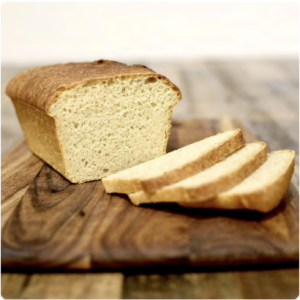Adding milk and butter to the Basic Sandwich Loaf recipe (in Baking with Rosehill Sourdough) with a slight change of flour and timeline produces a super soft, sliceable loaf with a mild sour flavor that is perfect for your favorite sandwich. This recipe also introduces the slap and fold kneading technique, which is great for wetter doughs where you need to mechanically develop gluten quickly. Like the Cinnamon Rolls recipe (in Baking with Rosehill Sourdough), this recipe calls for some sugar, so we need to develop the gluten structure mechanically and quickly before the fermentation gets underway. Note: If you’re using very strong bread flour, you may want to cut it with some all purpose flour or add in 3-5% more water. If you could do a standard knead without the slap and fold method, that is a sign the dough is probably too dry. If this happens, don’t add more water in, just take a note for next bake.
Yield
One 1kg Loaf (1kg/2lb standard loaf tin)
FEED
4-10 hours before PREP:
Mix 31g of sourdough with 62g of water 31g of bread flour and 31g of whole wheat flour (1:2:2). This will be enough for the recipe +20g.
Ingredients
For the dough:
115g warm milk (23%) (98˚F/37˚C)
200g warm water (40%) (98˚F/37˚C)
20g melted unsalted butter (4%)
12g salt (2.4%)
18g maple syrup (3.4%)
135g peaked sourdough starter (27%)
500g bread flour (100%)
For baking:
Butter for greasing the tin and melted butter for brushing the top of the dough.
PREP
5 hours before BAKE with 1 hour to make the dough and a 4 hour warm rest.
Target dough temperature is 80˚F (27˚C)
Mix: Combine warm milk, warm water, melted butter, maple syrup, and salt in a medium bowl.
Add starter and mix until water is milky in color.
Add flour. Mix just until combined, until you cannot see any dry flour. Dump out dough onto a clean surface and perform a slap and fold mixing technique for 5 minutes until well combined. You’ll know when the slap and fold is done when the dough starts to resemble a smooth ball. The dough shouldn’t be overly sticky at the end of the slap and fold. Maurizio over at The Perfect Loaf has an incredible write up and video on this technique here.
Let rest, covered with a damp towel or lid somewhere warm, 30 minutes.
[Feed the remaining starter for future use. You won’t need any more for this recipe.]
Folds: After the 30 minutes, fold using a coil fold technique. If the dough is too tense to coil fold, lift it out fo the bowl and use the tuck & rotate technique, stopping when the dough is smooth. Ensure the seam side is down and smooth side is up.
Let rest, covered, somewhere warm, 30 minutes.
Towards the end of the 30 minute rest, grease a loaf pan with butter and set aside, bring a small pot of water to boil, and melt a pat of butter.
After the 30 minutes, fold using a coil fold technique. If the dough is again too tense to coil fold, lift it out fo the bowl and place smooth side down onto a clean surface and stretch the width of your loaf tin and roll the dough into a log.
Place the dough into the greased loaf tin, smooth side up, seam side down. Brush the top of the loaf with the melted butter. Place the pot of boiling water into the back of your oven and place the loaf tin at the front. The hot water will create steam to keep the loaf from drying out and will keep the oven warm for proofing the dough.
Allow the dough to rest for 3-5 hours, until the dough has risen about ¾” above the rim of the tin.
After the 4 hours, remove the loaf and the pot of water from the oven.
Set the pot of water to boil again.
BAKE
Preheat oven to 350˚F (175˚C).
Once preheated, if your pot is oven safe, place it in the rear of your oven. If not, carefully pour the water into an oven safe container and place that into the oven.
Place the dough tin into the oven and bake for 45 minutes, turning halfway through the bake. Be careful of steam when opening the oven.
Allow to cool on a wire rack for 1 hour before slicing.
Makes a kid approved classic PB&J!
